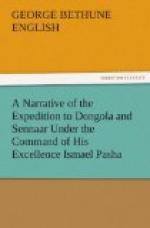12th of Safa. At an early hour, quitted the shore with a strong northerly wind, to pass the current which had stopped us yesterday. This day’s sail was the most agreeable of any we had enjoyed since we left Egypt, the river, since we had passed the rapids of Dall, (where the second cataract of the Nile properly commences,) having become as broad as in Egypt, and now flowing tranquilly through a country equally fertile, and much more picturesque than the finest parts of Said. The eastern bank of the river, particularly, presented a continual succession of villages, and fine soil crowded with trees, and all cultivated. Passed, during the day, some fine and large islands, also occupied by numerous villages. We stopped at night at one of these islands, by whose beautiful borders we had been sailing with great pleasure for more than four hours, with a stiff breeze. We were in formed by the inhabitants, that this island was a day’s walk in breadth. They said, that, as we advanced, we should find others as large and larger. Their island, they told us, was called Syee. They appeared to be well satisfied with their condition, having an abundance of every thing absolutely needful for a comfortable subsistence, and decent clothing of their own manufacture. What surprised me not a little, was to find the people as white as the Arabs of Lower Egypt, whereas the inhabitants of Nubia are quite black, though their features are not those of the Negro.
I have observed, that the country through which we passed to-day, was as fertile and much more picturesque than the Said. The reason for the latter part of this assertion is, that in the Said the view is limited by the ridges of barren and calcined mountains that bound it on both sides, whereas here the view ranges over plains bounded only by the horizon, and interspersed here and there with isolated mountains of most singular forms. Some of them might be mistaken for pyramids, they are so regular and well defined; some resembled lofty cones, and others resembled lofty square or pentagonal redoubts. One of the latter description lies upon the eastern bank of the river, and could easily be made an impregnable fortress, which could command all water communication between Egypt and Dongola. The scenes of verdure and cultivation through which we had passed today, removed all suspicions from my mind as to what had been reported to me of the great difference between Nubia and the country beyond it.
All the villages we have passed to-day, have in their centre a fort or castle, fortified with towers at the corners, and, judging from those we visited, resembling in their interior those on the cataract already described. The village, consisting of low huts, built of mud, is built round the walls of the fort, which is intended to serve as a place of retreat and defense for the inhabitants and their flocks, in case of alarm or attack. They are governed in the manner of the families of the patriarchs, the Sheck of the village being both judge and captain. Saw at this island a small skiff, the first boat belonging to the inhabitants of the country that I have seen since quitting Wady Halfa.




